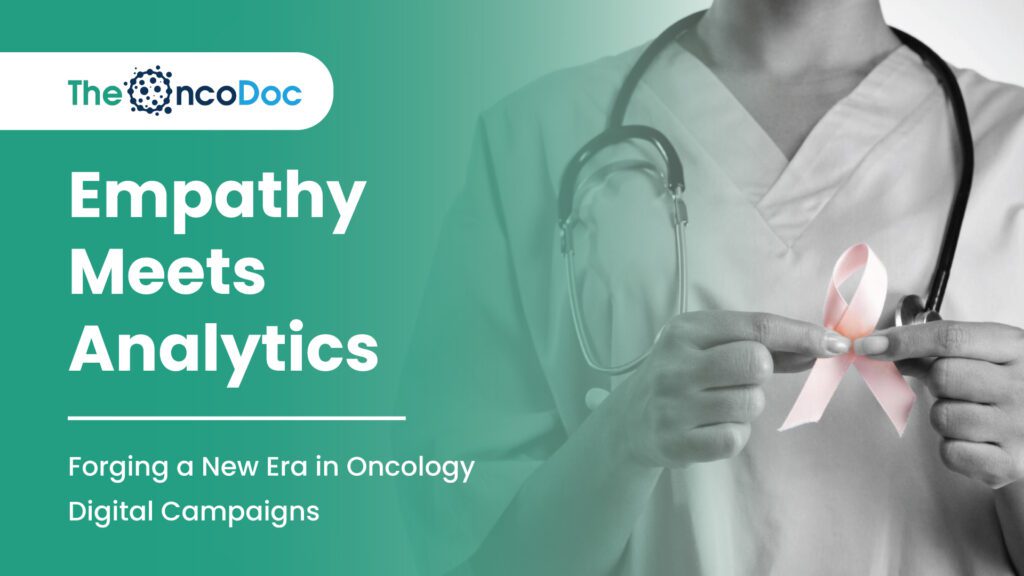Abstract
The landscape of oncology is rapidly evolving, driven by scientific advancements, personalized medicine, and an increasingly informed patient population. Concurrently, digital marketing has emerged as an indispensable tool for reaching and engaging stakeholders across the healthcare ecosystem. This article explores the critical intersection of empathy and analytics in designing inclusive digital campaigns within oncology. It argues that while data-driven strategies are paramount for optimizing reach and impact, true effectiveness in this sensitive field hinges on a profound understanding and integration of patient and caregiver experiences. We delve into how empathetic design principles, informed by robust analytics, can foster trust, enhance patient engagement, and ultimately improve health outcomes. Key areas of discussion include patient journey mapping, data-driven personalization, ethical considerations, and the measurable impact of inclusive digital strategies on awareness, adherence, and advocacy in oncology.
Introduction
Oncology, a domain characterized by its profound emotional and scientific complexities, presents unique challenges and opportunities for digital marketing. Unlike consumer goods, healthcare decisions, particularly in cancer, are deeply personal, often life-altering, and fraught with anxiety, hope, and uncertainty. For pharmaceutical companies, healthcare providers, and advocacy groups, the imperative is clear: communicate effectively, ethically, and empathetically. The digital realm, with its vast reach and sophisticated targeting capabilities, offers an unprecedented platform to achieve these goals.
However, the mere presence of digital channels is insufficient. The true power lies in how these channels are utilized. Traditional marketing often prioritizes reach and conversion metrics, but in oncology, the human element—empathy—must be at the core. Patients and caregivers are not just data points; they are individuals navigating complex diagnoses, treatments, and emotional landscapes. Therefore, successful digital campaigns in oncology must transcend conventional marketing paradigms, embracing a dual approach where the precision of analytics is harmonized with the profound understanding of empathy. This article will demonstrate how this synergy can lead to more inclusive, effective, and ethically sound digital campaigns that resonate deeply with the oncology community.
The Imperative of Empathy in Oncology Digital Marketing
Empathy in oncology digital marketing is not merely a buzzword; it is a foundational principle. Patients with cancer, their families, and caregivers often experience a spectrum of emotions, from fear and confusion to determination and hope. Digital content and interactions must acknowledge and respect this emotional reality. An empathetic approach means:
- Understanding the Patient Journey: The cancer patient journey is multifaceted, extending from initial symptoms and diagnosis through treatment, survivorship, or palliative care. Each stage presents distinct information needs, emotional states, and decision points. Empathetic digital campaigns map these journeys in detail, identifying critical touchpoints where relevant, supportive, and accessible information can be provided. This includes understanding the impact of a diagnosis on daily life, financial burdens, emotional well-being, and the need for support networks.
- Sensitive Language and Tone: The language used in oncology digital campaigns must be clear, compassionate, and free of jargon. It should avoid overly clinical terms that might alienate or confuse and instead focus on empowering patients with understandable information. The tone should be supportive, hopeful where appropriate, and always respectful of the patient’s autonomy and dignity.
- Addressing Diverse Needs: Inclusivity is a cornerstone of empathetic design. Cancer affects individuals from all walks of life, with diverse cultural backgrounds, socioeconomic statuses, health literacy levels, and digital access. Inclusive campaigns consider these variations, offering content in multiple languages, utilizing accessible formats (e.g., videos with captions, audio descriptions), and ensuring compatibility with various devices and internet speeds. It also means representing diverse patient populations in imagery and testimonials, fostering a sense of belonging and understanding.
- Building Trust and Credibility: In a landscape often rife with misinformation, trust is paramount. Empathetic campaigns build trust by providing accurate, evidence-based information from reputable sources. They are transparent about their objectives, whether it’s disease awareness, treatment education, or clinical trial recruitment. Patient testimonials, shared with explicit consent, can be powerful, but they must be authentic and reflect genuine experiences, not idealized outcomes.
The Power of Analytics in Oncology Digital Marketing
While empathy provides the human touch, analytics offers the strategic backbone for effective digital campaigns. Data-driven insights allow pharma companies and healthcare providers to understand their audience, optimize content, measure impact, and refine strategies for maximum effectiveness. Key analytical applications include:
- Audience Segmentation and Targeting: Advanced analytics enable the creation of highly granular audience segments based on demographics, online behavior, information needs, and even disease progression (where ethically permissible and data is anonymized). This allows for hyper-personalized messaging that resonates with specific patient groups, caregivers, or healthcare professionals. For instance, a campaign targeting newly diagnosed lung cancer patients will differ significantly from one aimed at oncologists seeking information on a new therapeutic agent.
- Content Performance Optimization: Digital analytics platforms (e.g., Google Analytics, social media insights) provide invaluable data on how content is consumed. Metrics such as page views, time on page, bounce rate, video completion rates, and click-through rates reveal what information is engaging and what is not. This data guides content strategy, allowing marketers to create more relevant and impactful articles, videos, infographics, and interactive tools. For example, if a particular blog post on managing chemotherapy side effects has high engagement, it signals a strong patient need for such practical guidance.
- Channel Effectiveness Measurement: Different digital channels—websites, social media, email marketing, search engine marketing (SEM), programmatic advertising—serve different purposes and reach different audiences. Analytics help determine which channels are most effective for specific campaign objectives. For example, social media might be excellent for building community and fostering peer support, while targeted email campaigns could be more effective for delivering personalized treatment information or appointment reminders.
- Conversion Tracking and ROI Calculation: Beyond engagement, analytics track conversions—whether it’s a download of an educational brochure, a sign-up for a support group, a request for more information, or even a clinical trial enrollment. By attributing these conversions to specific digital touchpoints, marketers can calculate the return on investment (ROI) of their campaigns, demonstrating their value to stakeholders and informing future budget allocation. This is crucial for pharma managers who need to justify marketing spend.
- Competitive Analysis and Trend Identification: Analytics tools can also monitor competitor activities and identify emerging trends in patient information seeking behavior or digital health consumption. This allows organizations to adapt their strategies, identify unmet needs, and maintain a competitive edge in a rapidly evolving digital landscape.
Designing Inclusive Digital Campaigns: The Synergy of Empathy and Analytics
The true art of effective oncology digital marketing lies in the seamless integration of empathy and analytics. This synergistic approach ensures that campaigns are not only data-driven but also deeply human-centered.
- Patient Journey Mapping with Data: Start by mapping the patient journey, but enrich it with analytical data. What are the common search queries at diagnosis? Which online communities do patients frequent during treatment? What information do caregivers seek most often? This data-informed journey mapping reveals pain points, information gaps, and opportunities for empathetic intervention. For example, if analytics show a surge in searches for “financial assistance for cancer treatment” at a particular stage, empathetic content addressing this concern can be proactively provided.
- Personalization Driven by Insights: Use analytics to personalize content delivery, but ensure this personalization is empathetic. Instead of just pushing product information, tailor educational resources, support group recommendations, or relevant clinical trial opportunities based on a patient’s specific cancer type, treatment stage, and expressed needs. This moves beyond generic messaging to a truly patient-centric experience. For instance, an email campaign triggered by a patient’s engagement with content on a specific side effect could offer further resources or suggest a discussion with their healthcare provider.
- Ethical Data Usage and Privacy: The collection and use of patient data in oncology marketing come with significant ethical responsibilities. Analytics must be deployed with strict adherence to privacy regulations (e.g., HIPAA, GDPR) and a commitment to data security. Transparency with patients about data collection practices and clear consent mechanisms are paramount. Empathetic analytics means using data to serve the patient’s best interest, not to exploit their vulnerability. It’s about empowering patients with information, not overwhelming them or making them feel surveilled.
- Measuring Empathetic Impact: While traditional metrics focus on reach and conversion, inclusive campaigns also need to measure empathetic impact. This can involve tracking engagement with support content, participation in online communities, sentiment analysis of patient feedback, and surveys on perceived helpfulness and trustworthiness of information. High engagement with patient stories or support forums, for example, can indicate that the empathetic tone is resonating.
- Iterative Optimization with a Human Lens: Analytics provides the feedback loop for continuous improvement. However, each iteration must be viewed through an empathetic lens. If analytics show low engagement with certain content, the question isn’t just “how to get more clicks,” but “is this content truly meeting an unmet patient need?” or “is the delivery method sensitive enough?” This iterative process, guided by both data and empathy, ensures campaigns remain relevant and impactful.
Case Studies and Practical Applications
To illustrate the synergy of empathy and analytics, consider these practical applications in oncology digital marketing:
- Disease Awareness Campaigns:
- Analytics: Identify high-volume search terms related to early symptoms, risk factors, and diagnostic procedures. Analyze geographic data to pinpoint areas with lower awareness or higher incidence rates. Track engagement with different content formats (e.g., infographics versus patient testimonials).
- Empathy: Develop content that destigmatizes cancer, encourages proactive health behaviors without inducing fear, and provides clear, actionable steps for early detection. Use diverse imagery and relatable narratives that reflect the target community. Offer easily accessible information on support resources.
- Synergy: A campaign might use geo-targeted social media ads (analytics) featuring a local cancer survivor’s story (empathy) to drive traffic to a microsite with symptom checkers and doctor locators, all while tracking conversion rates and user journeys to optimize the message and reach.
- Treatment Education and Adherence Programs:
- Analytics: Monitor patient portal usage, email open rates for treatment reminders, and engagement with educational videos on medication administration or side effect management. Analyze adherence rates correlated with digital intervention touchpoints.
- Empathy: Provide clear, concise, and visually appealing information about treatment protocols, potential side effects, and coping strategies. Offer personalized reminders and support messages that acknowledge the challenges of treatment. Create virtual support groups or forums where patients can share experiences.
- Synergy: An app (analytics) could deliver personalized medication reminders and side effect management tips (empathy), while also collecting anonymized data on patient adherence and reported side effects, allowing pharma companies to refine patient support programs and identify areas for educational improvement.
- Clinical Trial Recruitment:
- Analytics: Identify patient populations searching for advanced treatment options or specific trial criteria. Analyze referral patterns from healthcare professionals. Track conversion rates from initial interest to screening.
- Empathy: Frame clinical trials not just as scientific endeavors but as opportunities for hope and contribution to future cancer care. Provide clear, unbiased information about the trial process, potential risks and benefits, and patient rights. Offer accessible contact points for questions.
- Synergy: Targeted digital ads (analytics) could reach patients in specific geographical areas or with particular cancer types, leading them to a dedicated, empathetic landing page (empathy) that explains the trial in plain language, offers patient testimonials, and provides a direct contact form, with all interactions meticulously tracked for optimization.
Challenges and Future Directions
While the integration of empathy and analytics holds immense promise, several challenges remain:
- Data Privacy and Security: Ensuring robust data privacy and security measures is paramount, especially with sensitive health information.
- Health Literacy Gaps: Designing content that is universally understandable across varying levels of health literacy remains a challenge.
- Digital Divide: Bridging the digital divide to ensure equitable access to information for all patient populations is crucial.
- Measuring Empathetic Outcomes: Developing standardized metrics for measuring the qualitative impact of empathetic campaigns requires further research.
The future of oncology digital marketing will undoubtedly see an even deeper integration of artificial intelligence (AI) and machine learning (ML) to enhance personalization and predictive analytics. However, it is critical that these technological advancements remain tethered to ethical considerations and a steadfast commitment to empathy. AI can help identify patterns and deliver tailored content, but human oversight and a profound understanding of the patient experience will always be essential to ensure that digital campaigns in oncology are not just effective, but also compassionate and truly inclusive.
Conclusion
In the complex and emotionally charged world of oncology, digital campaigns must move beyond mere transactional interactions. The fusion of empathy and analytics offers a powerful paradigm for designing inclusive digital strategies that genuinely serve the needs of patients, caregivers, doctors, and pharma managers. By leveraging data to understand nuanced behaviors and preferences, while simultaneously infusing every touchpoint with compassion, respect, and a commitment to inclusivity, the oncology community can build trust, empower patients, and ultimately contribute to better health outcomes. This dual approach is not just a best practice; it is an ethical imperative that defines the next generation of digital engagement in cancer care.
The Oncodoc team is a group of passionate healthcare and marketing professionals dedicated to delivering accurate, engaging, and impactful content. With expertise across medical research, digital strategy, and clinical communication, the team focuses on empowering healthcare professionals and patients alike. Through evidence-based insights and innovative storytelling, Hidoc aims to bridge the gap between medicine and digital engagement, promoting wellness and informed decision-making.



